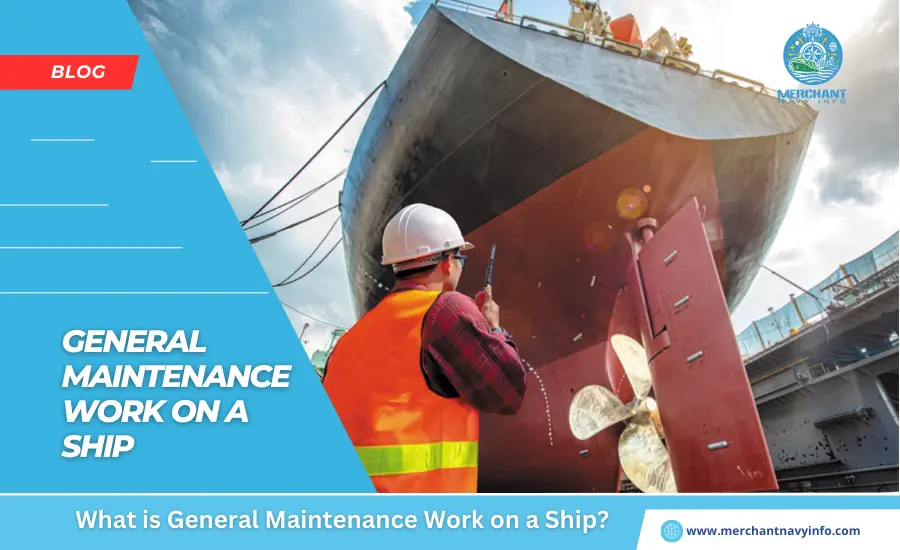
Maintenance means ensuring that machines and equipment continue to operate. Whether it is a small machine or a large structure, efficient maintenance contributes to a longer service life and better results. Ships require maintenance to keep their machinery up to date-and running smoothly. In this article, you will learn how ship General Maintenance is carried out. Most of the machinery is located in the ship’s engine room and is maintained by technicians and crew to ensure safe and efficient operation. All machinery on board requires maintenance and must be performed regularly. Previously, ships had large crews and technicians, which made maintenance quick and easy.
However, in the current scenario, the number of ship’s crew and technicians has been significantly reduced. Many ships have only 3-4 engineers on board, reducing even the time required for ship maintenance. General Maintenance requires manpower and time, which is not always available due to the small number of workers and the large number of machines. Therefore, it is important to plan machine maintenance in advance so that the machine can be properly overhauled and maintained. Generally, a second engineer is required to plan the ship’s maintenance schedule. Efficient planning and proper use of equipment are the keys to productive maintenance. This article describes the main maintenance procedures performed on ships.
What is Ship General Maintenance?
Ship General Maintenance planning aims to complete the maximum amount of repair and maintenance work in the least amount of time and cost. Maintenance work involves keeping machinery up-to-date and trouble-free to ensure the seaworthiness of the vessel. Proper maintenance will extend the life of your vessel, increase efficiency, and prevent mechanical failure. Ship maintenance is planned. There are two different approaches to performing maintenance:
- reactive
- proactive.
Corrective maintenance is performed as soon as an incident occurs. A proactive approach has a planned and preventive aspect. Maintenance procedures are carried out in accordance with the certification body’s strict safety and precautionary regulations.
General Procedures For Ship Maintenance
A detailed plan is created specifying the tasks and protocols to be followed, their frequency, and the follow-up work to be performed. These procedures are aimed at increasing the efficiency of the vessel and its equipment, keeping an eye on any incidents and avoiding unplanned downtime.
Types Of Maintenance Procedures
1. Preventive Maintenance System Or Planned Maintenance System
This is known as PMS or Planned Maintenance System. In this type of system, maintenance is performed according to machine operating hours (e.g. 4000 hours, 8000 hours, etc.) or calendar intervals (e.g. Six months, one year, etc.) Maintenance is performed regardless of the machine’s condition. Parts must be replaced on schedule, even if they are still usable.
2. Corrective Maintenance
This system performs maintenance when a machine breaks down. For this reason, it is also called breakdown maintenance. This is not a good and appropriate method as a situation may arise where you need the machine urgently. The only advantage of this system is that the mechanical parts function throughout their lifetime or until failure. If this system fails, several other parts may also be damaged, which can be costly.
3. Condition Maintenance System
This is a system for regularly inspecting mechanical parts. We use sensors and other devices to regularly record machine conditions and perform vessel maintenance accordingly. This system requires experience and knowledge. Incorrect interpretation can damage the machine and result in expensive repairs that are unacceptable to the company.
Various Aspects Of Vessel Maintenance Procedures Include:
Information Gathering:
This includes assembly plans, procedures, and instructions for machine vessel maintenance and parts replacement. Provided by the machine manufacturer.
Plan:
A plan is created to plan various vessel maintenance tasks. Any maintenance work that needs to be carried out in the dry dock will be planned accordingly.
Task Assignment:
Tasks are assigned to each crew member according to their skills and objectives. Administrative controls take precedence.
Execution:
The maintenance plan is executed by the chief engineer. Crew members perform their assigned tasks. Maintenance tasks are logged in the maintenance log for future reference.
Analysis:
General Maintenance logs are used to analyze the condition of the ship and prepare it for future purposes. Check the engine and drive system regularly. Keeping the engine and propulsion system in good condition is critical to the performance of your vessel. Check fluid levels, temperature, and voltage regularly to ensure everything is working properly. One of the most important things to check during engine maintenance is the fluid level. Make sure all fluids in the engine are at the correct levels, especially oil and coolant. If these values are too low, problems such as overheating and poor performance can occur. It is also important to ensure that the engine temperature is within a safe range.
Conclusion
By taking care of these simple tasks, you can help to ensure that your ship stays in good condition for years to come. So don’t neglect the importance of general maintenance – it could save you a lot of time and money in the long run! You can also take your ship to a ship repair yard for maintenance work but you need to find a reliable ship repair company.









